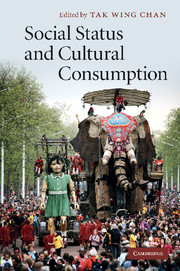Book contents
- Frontmatter
- Contents
- List of figures
- List of tables
- List of contributors
- Acknowledgments
- 1 Social status and cultural consumption
- 2 The social status scale: its construction and properties
- 3 Social stratification and musical consumption: highbrow–middlebrow in the United States
- 4 Bourdieu's legacy and the class–status debate on cultural consumption: musical consumption in contemporary France
- 5 Social status and public cultural consumption: Chile in comparative perspective
- 6 Social stratification and cultural participation in Hungary: a post-communist pattern of consumption?
- 7 Status, class and culture in the Netherlands
- 8 Social stratification of cultural consumption across three domains: music; theatre, dance and cinema; and the visual arts
- 9 Conclusion
- References
- Index
3 - Social stratification and musical consumption: highbrow–middlebrow in the United States
Published online by Cambridge University Press: 07 May 2010
- Frontmatter
- Contents
- List of figures
- List of tables
- List of contributors
- Acknowledgments
- 1 Social status and cultural consumption
- 2 The social status scale: its construction and properties
- 3 Social stratification and musical consumption: highbrow–middlebrow in the United States
- 4 Bourdieu's legacy and the class–status debate on cultural consumption: musical consumption in contemporary France
- 5 Social status and public cultural consumption: Chile in comparative perspective
- 6 Social stratification and cultural participation in Hungary: a post-communist pattern of consumption?
- 7 Status, class and culture in the Netherlands
- 8 Social stratification of cultural consumption across three domains: music; theatre, dance and cinema; and the visual arts
- 9 Conclusion
- References
- Index
Summary
Introduction
In earlier research (Alderson et al., 2007), we used the General Social Survey (Davis et al., 2003) to identify and analyse styles of cultural consumption that emerge across domains of cultural activity in a nationally representative sample of US residents. Motivated theoretically by three broad views of the relationship between stratification and cultural consumption – the homology, individualisation and omnivore–univore arguments (see Chapter 1) – we examined responses to a set of survey items regarding respondent participation in activities as diverse as reading, attending the theatre, visiting an art museum and attending a rock, country, or rap performance. We found that contemporary cultural consumers cluster into a small number of recognisable patterns, patterns that are more consistent with the omnivore–univore thesis than they are with the alternatives. When we modelled these styles of consumption, we found that an explicit measure of social status emerged as the central ‘stratification-related’ variable defining such styles, and that the role of social status was large relative to other sociodemographic and compositional factors. For instance, individuals at the highest social status were 8.3 times more likely to be ‘omnivores’ across these domains than they were to be members of a comparatively inactive group of cultural consumers. By comparison, individuals with the highest educational credentials were 5.4 times more likely and individuals at the highest income were 3.7 more likely.
In this chapter, we move from the analysis of cross-domain styles of cultural consumption to examine consumption within a single domain – that of music. Our choice here is purposive.
- Type
- Chapter
- Information
- Social Status and Cultural Consumption , pp. 57 - 83Publisher: Cambridge University PressPrint publication year: 2010
- 5
- Cited by



